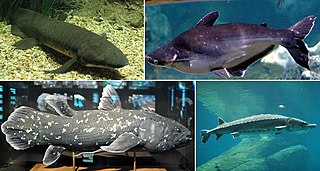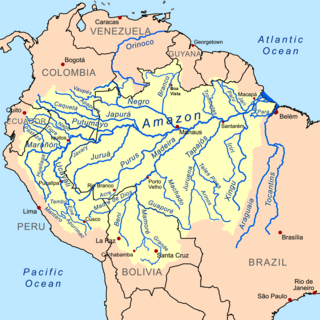
Osteichthyes, commonly referred to as the bony fish, is a diverse superclass of vertebrate animals that have skeletons primarily composed of bone tissue. They can be contrasted with the Chondrichthyes, which have skeletons primarily composed of cartilage. The vast majority of extant fish are members of Osteichthyes, which is an extremely diverse and abundant group consisting of 45 orders, over 435 families and 28,000 species. It is the largest class of vertebrates in existence today.

Fish sauce is a liquid condiment made from fish or krill that have been coated in salt and fermented for up to two years. It is used as a staple seasoning in East Asian cuisine and Southeast Asian cuisine, particularly Myanmar, Cambodia, Laos, Philippines, Thailand, and Vietnam. Some garum-related fish sauces have been used in the West since the Roman times.

The term carp is a generic common name for numerous species of freshwater fish from the family Cyprinidae, a very large clade of ray-finned fish mostly native to Eurasia. While carp are prized quarries and are valued as both food and ornamental fish in many parts of the Old World, they are generally considered useless trash fish and invasive pests in many parts of Africa, Australia and most of the United States.

Tilapia is the common name for nearly a hundred species of cichlid fish from the coelotilapine, coptodonine, heterotilapine, oreochromine, pelmatolapiine, and tilapiine tribes, with the economically most important species placed in the Coptodonini and Oreochromini. Tilapia are mainly freshwater fish inhabiting shallow streams, ponds, rivers, and lakes, and less commonly found living in brackish water. Historically, they have been of major importance in artisanal fishing in Africa, and they are of increasing importance in aquaculture and aquaponics. Tilapia can become a problematic invasive species in new warm-water habitats such as Australia, whether deliberately or accidentally introduced, but generally not in temperate climates due to their inability to survive in cold water.

The Amazon basin is the part of South America drained by the Amazon River and its tributaries. The Amazon drainage basin covers an area of about 6,300,000 km2 (2,400,000 sq mi), or about 35.5 percent of the South American continent. It is located in the countries of Bolivia, Brazil, Colombia, Ecuador, Guyana, Peru, Suriname, and Venezuela, as well as the territory of French Guiana.

Clonorchis sinensis, the Chinese liver fluke, is a liver fluke belonging to the class Trematoda, phylum Platyhelminthes. It infects fish-eating mammals, including humans. In humans, it infects the common bile duct and gall bladder, feeding on bile. It was discovered by British physician James McConnell at the Medical College Hospital in Calcutta (Kolkata) in 1874. The first description was given by Thomas Spencer Cobbold, who named it Distoma sinense. The fluke passes its lifecycle in three different hosts, namely freshwater snail as first intermediate hosts, freshwater fish as second intermediate host, and mammals as definitive hosts.

A fish is an aquatic, craniate, gill-bearing animal that lacks limbs with digits. Included in this definition are the living hagfish, lampreys, and cartilaginous and bony fish as well as various extinct related groups. Approximately 95% of living fish species are ray-finned fish, belonging to the class Actinopterygii, with around 99% of those being teleosts.
Tylognathus is an invalid genus of ray-finned fishes in the family Cyprinidae. It was established by Heckel in 1843 without a type species. Varicorhinus diplostomus, described by Heckel in 1838 and erroneously redescribed by the same author in 1844 as T. valenciennesii, was later designated the type species. Today this fish is placed in the genus Bangana.

Abbottina is a genus of ray-finned fish in the family Cyprinidae, the carps and minnows. They are native to eastern Asia. The genus was named for the American zoologist James Fisher Abbott, student at Stanford University and later professor of English at Naval Academy Etajima and of zoology at Washington University in St. Louis.
Abbottina binhi is a species of ray-finned fish in the genus Abbottina. It is endemic to the Bằng River in Cao Bằng Province, Vietnam. It is only known from its type series.
Abbottina lalinensis is a species of ray-finned fish in the genus Abbottina.
Abbottina obtusirostris is a species of ray-finned fish in the genus Abbottina who are found in the upper Yangtze River in Szechwan, China.

Abbottina rivularis, also known as the Chinese false gudgeon or the Amur false gudgeon is a species of ray-finned fish in the family Cyprinidae, the carps and minnows. It is native to China, Korea, and Japan, but it has been introduced to the Mekong River Basin and is also known from rivers in Turkmenistan.

Sinamia is an extinct genus of freshwater amiiform fish which existed in China, Japan, and possibly South Korea during the Early Cretaceous period. Like the related bowfin, it has an elongated low-running dorsal fin, though this was likely convergently evolved.
Juchilestes is an amphidontid mammal genus from the early Cretaceous. It lived in what is now the Beipiao of western Liaoning, eastern China. It is known from the holotype D2607, which consists of three-dimensionally preserved, partial skull with mandibles and some teeth. It was found in 2004 from the Lujiatun Site of the Yixian Formation. It was first named by Chun-Ling Gao, Gregory P. Wilson, Zhe-Xi Luo, A. Murat Maga, Qingjin Meng and Xuri Wang in 2010 and the type species is Juchilestes liaoningensis.

Gobioninae is a monophyletic subfamily of Eurasian cyprinid fishes. A species-rich subfamily, it is divided into five tribes: Gobionini, Pseudogobionini, Hemibarbini, Coreiini, and Sarcocheilichthyini.

Daliansaurus is a genus of small troodontid theropod dinosaur, measuring approximately 1 metre long, from the Early Cretaceous of China. It contains a single species, D. liaoningensis, named in 2017 by Shen and colleagues from a nearly complete skeleton preserved in three dimensions. Daliansaurus is unusual in possessing an enlarged claw on the fourth digit of the foot, in addition to the "sickle claw" found on the second digit of the feet of most paravians. It also has long metatarsal bones, and apparently possesses bird-like uncinate processes. In the Lujiatun Beds of the Yixian Formation, a volcanically-influenced region with a cold climate, Daliansaurus lived alongside its closest relatives - Sinovenator, Sinusonasus, and Mei, with which it forms the group Sinovenatorinae.
Gelastorhinus is a genus of grasshoppers in the subfamily Gomphocerinae. Species have been recorded from tropical Africa and Asia.

Changmiania is a genus of basal ornithopod dinosaur that lived in what is now China during the Early Cretaceous. It contains a single species, Changmiania liaoningensis.

Aneuretopsychidae is an extinct family of scorpionflies known from the Mesozoic. Fossils are known from the Jurassic (Callovian-Oxfordian) to the early Late Cretaceous (Cenomanian). It is part of Mesopsychoidea, a group of scorpionflies with siphonate proboscis. They are suggested to have been nectarivores, feeding off the liquid pollination drops of and acting as pollinators for now extinct insect pollinated gymnosperms such as Bennettitales.












